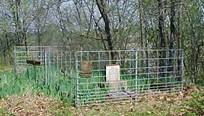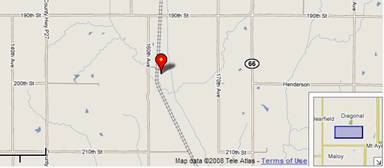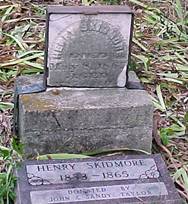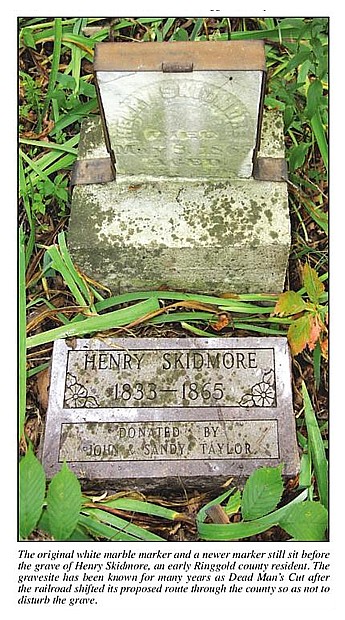 |
 
|
| |
| |
| |
| |
| |
| |
| |
| |
| |
| |
| |
| |
| |
| |
| |
| |
| |
| |
| |
This site is supported by
Friends of IAGenWeb |
 |
| site search by freefind | advanced |
DEAD MAN'S CUT
rural Diagonal, Washington Township, Ringgold County, Iowa
 Dead Man's Cut is located in Washington Township of Ringgold County, 5 ½ miles south of Diagonal; or, 3 ½ miles north of Benton; or, approximately 10 miles northwest of Mount Ayr. The monument is located on the east side of the railroad track on land owned by G. M. Novak (1978).
Dead Man's Cut is located in Washington Township of Ringgold County, 5 ½ miles south of Diagonal; or, 3 ½ miles north of Benton; or, approximately 10 miles northwest of Mount Ayr. The monument is located on the east side of the railroad track on land owned by G. M. Novak (1978).
Photograph Contributor GH
Feature Name: Dead Man's Cut
 Feature Type: cemetery
Feature Type: cemetery
State: Iowa
County: Ringgold
USGS 7.5' x 7.5' Map: Diagonal
Latitude: 404525N
Longitude: 0942117W
Map provided by google maps
INTERMENT:
SKIDMORE, Henry
b. 16 Apr 1833, Owen Co., IN d. 08 May 1865, Diagonal, Ringgold Co., IA
 There is a lonely spot along the CGW [tracks] about half way between Diagonal and Benton, Iowa where Wolf Creek empties into the Grand River, better know to railroaders as "Dead Man's Cut". Henry SKIDMORE was, according to an article in the Commuter for 1 March 1982, a considerable Indian fighter on the frontier, he and his companions would steal herds of Indian ponies and on one occasion in Nebraska they were lucky to escape with their lives; Henry SKIDMORE was incapacitated for weeks from injuries from Indian arrows.
There is a lonely spot along the CGW [tracks] about half way between Diagonal and Benton, Iowa where Wolf Creek empties into the Grand River, better know to railroaders as "Dead Man's Cut". Henry SKIDMORE was, according to an article in the Commuter for 1 March 1982, a considerable Indian fighter on the frontier, he and his companions would steal herds of Indian ponies and on one occasion in Nebraska they were lucky to escape with their lives; Henry SKIDMORE was incapacitated for weeks from injuries from Indian arrows.
He homesteaded a farm about halfway between Benton and Diagonal, Iowa and died (and was buried) there on 8 May 1865.
His widow Orila was living in 1870 in Mt. Ayr Township, Ringgold County, Iowa, with her daughter: Ellen and her sons: George, Frank and William H. SKIDMORE who were attending school.
He was buried in Skidmore Cemetery. It states that he was the only grave in that cemetery at Dead Man's Cut on Railroad South of Diagonal Road. When the railroad was coming, they put the curve there to avoid the cemetery.
Many are the weird stories told about him. Every railroad man in the early days had a different story as to how he met his death. All stories are erroneous, as he died a natural death. In May 8, 1865, Henry SKIDMORE was buried on his family farm some five miles south and a bit west of Diagonal.
Twenty-two years later the Chicago Great Western railroad was built with the grave lying in the proposed path of the rails. To accommodate the grave site, and in marked contrast to present methods, these tracks were curved to the west, leaving intact the grave and white marble headstone atop the cut.
The stone fell in recent years and was placed upright in a steel frame by a fourth generation farmer, John TAYLOR, of the neighborhood. For one and one-quarter centuries, that stone has endured Iowa weather's blazing sun, torrential rain, howling blizzard, and bitter cold. Over the years Dead Man's Cut has been visited and re-visited by young and old who have heard the story. As of 1985, the railroad is gone, passed into history.
At any season, the stone's inscription can be deciphered – "Henry SKIDMORE, May 8, 1865. Aged 37 years, 22 days." Each succeeding Iowa spring a clump of ancient iris, pale in color, sturdy in strength, blossoms there, planted, no doubt, by loving, caring hands. New stone was purchased and set by John and Sandy TAYLOR of Diagonal. Fence was erected by Rick WILEY of Diagonal in May of 2001.
SOURCE: Diagonal, Iowa Centennial History Book, published 1988
![]()
"The Grave By The Railroad Track"
There is a lonely spot on the Chicago Great Western Railroad about half-way between the towns of Benton and Diagonal, Iowa, where the Wolf Creek empties into the Grand River. On a little knoll near by lies the body of Henry SKIDMORE. This is "Dead Man's Cut" and is known by every railroader who ever walked over this piece of track. Railroad presidents of many railroads and even President Woodrow WILSON have ridden by this lonely grave and their attentions were called to this early pioneer or border man whose body lies buried there, with his grave marked by a small tombstone.
His was a life of the early pioneer. As a small boy, his parents moved from Ohio to the western frontier. He grew up and owned or homesteaded a farm near the town of Marshall. Now the Marshalltown cemetery is the only remembrance of that pioneer village.
I grew up as a boy in the town of Benton and I have heard all of the terrible stories about Henry SKIDMORE, for I was eager to sit and listen to them, as told by the old-timers of Ringgold County. But now I know better. All of his acts were good ones instead of bad ones. He was born April 4, 1828 and died a natural death at the early age of 37 on May 8, 1865. He requested to be buried on his farm, where now the railroad runs.
The railroad did not come through his farm until 1877. In fact, he was buried 12 years before the railroad arrived. While I was a boy, I never failed to place flowers on his grave on Decoration Day, and when as a young man I worked on the railroad, I kept the weeds mowed, so that his grave could be plainly seen from the passing trains. Many are the weird stories told about him. Every railroad man in the early days had a different story as to how he met his death. Some said he was a horse thief; others said he was a murderer; others said he was killed by Indians and was hanged and buried there. These are all erroneous and without foundation.
As the trains go by with their long and weird whistles, there is never a time that the thought doesn't come to men on those trains that they are passing "Dead Man's Cut" and wonder about the lonely grave on that little knoll by the railroad right-of-way. Does he hear the rumble of their long trains as they travel by his quiet resting place?
He was a cousin to my mother, who was born in Ringgold County. When her parents arrived there were only 309 people in the county so that her knowledge was very good of the early life of Henry SKIDMORE. It is true he was an Indian killer, always watching the Indians and driving them westward. He was never without his long rifle.
One story I remember quite well was that he and one of his border companions, also a hunter and trapper, Aeif ROUDABUSH, were tracking deer near the mouth of Wolf Creek and Grand River. They noticed that they were being trailed by two Indians. There was a foot log across the Grand River and [the] two who were trailing them crossed the foot log which Henry and Aeif had walked over only a few minutes before. They were hidden and as the two Indians reached the center of the log, they shot them, letting their bodies fall in the river. As their unerring shot never missed, they did not go back to look but went on their way, letting the Indians' bodies float down the river.
In the early spring sometimes they would raid the Indian villages. They would steal the Indians' horses and at times came back with whole herds of Indian ponies, but they were not always lucky.
One story I remember is the raiding of a band of Indians living in Nebraska, and they were lucky to get back with their own hides and were laid up for weeks due to several bow and arrow injuries they received.
He was a constant hunter and killer of Indians and was never without his long rifle wherever he went, for there was always that constant thought that an Indian might be hidden behind the next tree. For Iowa and the Central West were almost a wilderness at that time.
He was one of the border men of the early eighteen hundreds when the Indians and buffalo and other wild game roamed the country. All of these stories about him being a horse thief, a murderer, and being hanged at this lonely spot and other bad stories about him are false. For he was only one of the men who helped settle the country when Iowa, Illinois and Nebraska were the Western Frontier.
He sleeps in his lonely grave by the railroad track where the long trains pass by awaiting the great Judgment Morning when he will again take his place as one of the great early frontiersmen of the midwest. I ran a train over the railroad track through Benton and Diagonal and I never failed to look for the tombstone of Henry SKIDMORE on the little knoll at "Dead Man's Cut."
NOTE: According to the 1856 Iowa Census, Platte Township of Ringgold County:
Henry SKIDMORE, Farmer, aged 28, born [April 16, 1828] in [Owen Co.] Indiana
Ovelia [Orila (AULT)] SKIDMORE, aged 27, born in Indiana
Donecy SKIDMORE, aged 5, born in Illinois
Ellen SKIDMORE, aged 2, born in Indiana
Charles SKIDMORE, aged 1, born in Iowa
The 1860 U.S. Census includes two more sons, Henry aged 3 and George aged 1.
Also residing in Platte Township of Ringgold County, 1856 Iowa Census:
John SKIDMORE, Farmer, aged 22, born in Indiana
Elizabeth SKIDMORE, aged 21, born in Indiana
Frances SKIDMORE, age 3, born in Illinois
Laura SKIDMORE, aged 1, born in Iowa
Henry was born in Owen County, Indiana, the son of William and Mary Ann Elizabeth (MUMPOWER) SKIDMORE. His siblings were John, Mary Jane and Peter Parley SKIDMORE. Henry and Orila AULT were married in Iowa on August 12, 1848, and were the parents of Doncey, Ellen, Charles Richard, Henry, George W., Frank and William H. SKIDMORE.
Additional Source: BANNER, Raymond. Ringgold County Cemeteries.
Transcriptions and note by Sharon R. Becker; updated June of 2012

Mount Ayr Record-News
Mount Ayr, Ringgold County, Iowa
Thursday, September 26, 2013
 What is "Dead Man's Cut"?
What is "Dead Man's Cut"?
Many long-time Ringgold county residents may be familiar with the story about the solitary grave site that caused a great railroad to alter its proposed route through the county, but few may know the whatever became of the grave in recent years.
According to a short entry in the book "Diagonal Centennial history," the grave marks the final resting place of Henry SKIDMORE. Despite several legends attributing his death to a variety of exotic causes, SKIDMORE, 37, actually died of natural causes in May 1865 and was buried on a plot of ground on his family farm south of Diagonal near the confluence of Wolf Creek and Grand River.
Twenty-two years after his death, the Chicago Great Western railroad was planning its new route through Ringgold county. They discovered, however, their route ran directly across SKIDMORE'S grave site. Rather than move the grave, the railroad shifted its route a few yards west to leave the site untouched.
The original white marble grave marker still adorns SKIDMORE'S grave, thanks to John and Sandy TAYLOR, former neighbors to the site. After the marker had fallen, TAYLOR devised a steel fram to keep the stone erect. In addition, some years later, the TAYLORS donated a more modern marble grave marker that sits directly in front of the origianl stone to reserve the site for prosperity. The gravesite is surrounded by a short steel fence.
Those wishing to visit Dead Man's Cut should be aware the site sits on private property and is not accessible by a public roadway.
Incidently, why was the spot named "Dead Man's Cut"? A former railroad engineer offered a possible definition: "cuts" were made in terrain to allow track to be laid in a flatter grade than the hill it's laid on. SKIDMORE'S grave sits atop a steep rise overlooking the old railway bed - thus Dead Man's Cut is forever part of the legends of Ringgold County.

Mount Ayr Record-News
Mount Ayr, Ringgold County, Iowa
Thursday, October 03, 2013
Letter to the Editor:
I believe Henry SKIDMORE was actually 37 when he died in 1865. (Front page of September 26 Record-News).
The original stone is broken across the aged numbers causing the confusion. However after visiting the stone myself, I am confident the correct age is "37". The second digit of his age is cut straight across the top and deep on the vertical cut, typical of 7's on old stones. The "22" days provide the most evidence. The 2's are arched across the top with a curl on the top point. The second age year digit is not arched nor curled further supporting the "37" conclusion.
Other sources seem to confirm the 37 age. The 1856 Iowa census lists him as being 28 years old which would place his birth in 1828 and an age of 37 at his death in 1865. This would make the TAYLOR replacement stone birth year incorrect.
Tony Mercer
Tingley


above, or go to IAGenWeb Gravestone Photo Project's submission page
Thank You for stopping by!
© Copyright 1996- Ringgold Co. IAGenWeb Project All rights Reserved. |

